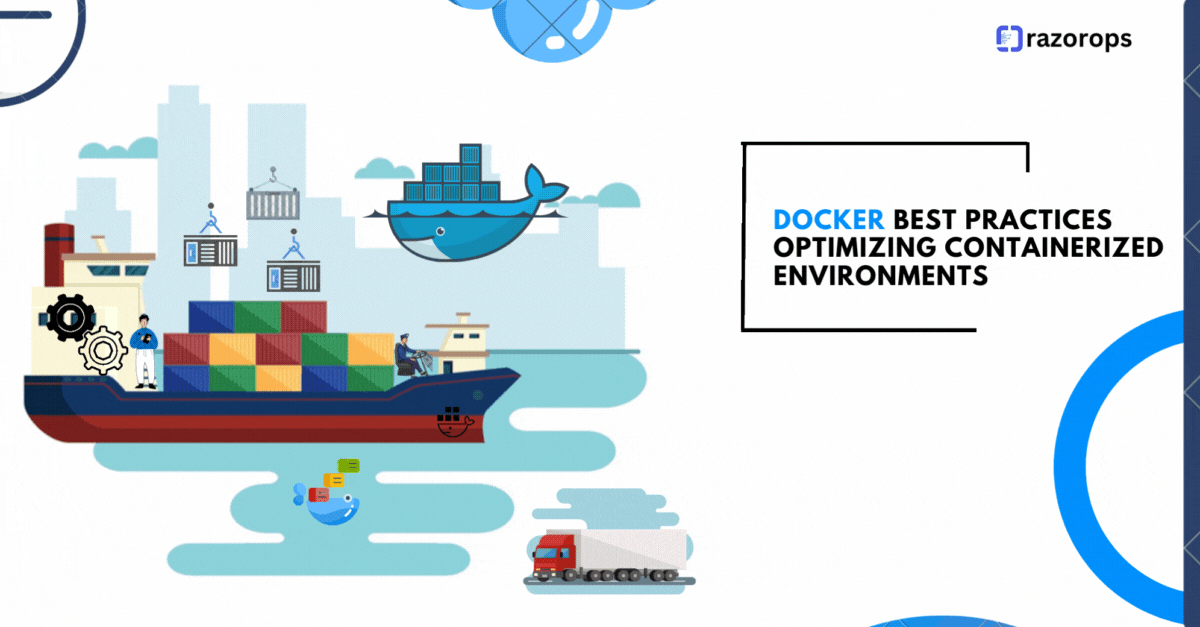
Docker Best Practices Optimizing Containerized Environments
Docker has revolutionized the way software is developed, allowing for greater flexibility, scalability, and portability across different environments. However, to fully harness the potential of Docker containers and ensure optimal performance, it’s essential to implement best practices that address efficiency, security, and management. Let’s explore some key strategies for optimizing Docker container environments.
1. Image Optimization
a. Use Efficient Base Images:
-
Start with minimal base images like Alpine Linux to reduce container size and vulnerabilities.
-
Leverage multi-stage builds to minimize the final image size.
b. Properly Layer Images:
-
Optimize layers by grouping similar operations and minimizing the number of layers.
-
Utilize .dockerignore to exclude unnecessary files from the build context.
2. Container Configuration
a. Limit Resources:
-
Set resource constraints (CPU, memory) to prevent a single container from monopolizing resources and affecting others.
-
Utilize Docker Compose or Kubernetes to manage resource allocation across multiple containers.
b. Implement Health Checks:
-
Define health checks to monitor container status and ensure continuous operation.
-
Incorporate restart policies to automatically recover failed containers.
3. Security Best Practices
a. Regular Image Updates:
-
Stay updated with security patches by regularly updating base images and dependencies.
-
Use trusted sources for base images and avoid images with known vulnerabilities.
b. Implement Least Privilege:
-
Employ non-root users whenever possible within containers to limit potential exploits.
-
Utilize Docker’s capabilities to drop unnecessary privileges.
4. Storage and Volumes
a. Use Named Volumes:
-
Employ named volumes for persistent data, separating it from the container filesystem.
-
Utilize Docker’s volume plugins for scalable and efficient data management.
b. Consider Storage Driver:
- Choose storage drivers based on performance requirements and compatibility with the underlying infrastructure.
5. Monitoring and Logging
a. Centralized Logging:
-
Use logging drivers to forward container logs to centralized systems for easy monitoring and analysis.
-
Employ tools like ELK Stack (Elasticsearch, Logstash, Kibana) for comprehensive log management.
b. Monitoring Tools:
-
Utilize Docker stats and third-party monitoring solutions to track container performance metrics.
-
Implement alerts based on predefined thresholds for proactive issue resolution.
6. Networking Optimization
a. Use Container Networks:
-
Leverage Docker networks for efficient communication between containers.
-
Implement network segmentation for improved security and isolation.
b. Container Orchestration:
- Utilize orchestration tools like Kubernetes or Docker Swarm for efficient networking and service discovery.
Keep Containers Lightweight:
-
Utilize Alpine or slim base images to reduce container size.
-
Minimize the number of layers in your images to enhance build speed and decrease storage requirements.
Use Multi-Stage Builds:
- Employ multi-stage builds to streamline the final image size by eliminating unnecessary build dependencies and artifacts.
Optimize Container Resources:
-
Set appropriate resource limits (CPU, memory) to prevent resource contention and ensure predictable performance.
-
Monitor and adjust resource allocation based on application demands using tools like cAdvisor or Prometheus.
Implement Security Best Practices:
-
Regularly update base images and dependencies to patch vulnerabilities.
-
Employ Docker Content Trust and verify image integrity with digital signatures.
-
Utilize least privilege principles by running containers with the least necessary permissions.
Use Docker Compose Effectively:
- Leverage Docker Compose for managing multi-container applications, simplifying orchestration, and defining complex setups.
Utilize Persistent Storage:
- Use Docker Volumes or Bind Mounts to persist data outside containers, ensuring data durability and easier container management.
Implement Health Checks:
- Set up health checks to monitor container status and automatically restart or take action if the container becomes unhealthy.
Container Logging and Monitoring:
-
Centralize container logs using tools like ELK stack or fluentd for easier troubleshooting and analysis.
-
Implement monitoring tools (Prometheus, Grafana) to gather container metrics and identify performance bottlenecks.
Networking Best Practices:
-
Leverage Docker’s networking modes effectively, considering the requirements of your application (bridge, overlay, host).
-
Secure container communication by isolating networks and using encryption where necessary.
Automate Container Management:
- Use container orchestration tools like Kubernetes or Docker Swarm for automated deployment, scaling, and management of containers.
Optimizing Docker container environments involves a combination of resource management, security measures, and efficient deployment strategies. By adhering to these best practices, developers and DevOps teams can ensure their containerized applications run efficiently, securely, and reliably, unlocking the full potential of Docker’s capabilities while minimizing potential risks and challenges.
Tutorials & Guides
CI/CD Pipelines with Kubernetes
Top Reading Recommendations
Upcoming Events
Keptn Public Technical Committee meeting
Jan 17 -2:30 AM – 3: 15PM (PST)
Keptn Community Meeting - US / NorAm / EMEA
Jan 17 -9:00 – 10: 00PM (PST)
OpenFeature Community Meeting
Jan 18 -8:30 – 9: 30PM (PST)
DevOps Jobs
Google - Check out all the jobs
here
Accenture -Check out all the jobs here
Infosys -Check out all the jobs here
Microsoft -Check out all the jobs
here

PS- We publish this newsletters every week, Subscribe and share with your friends. We hope this newsletter has provided valuable information. Follow RazorOps Linkedin Page Razorops, Inc.





